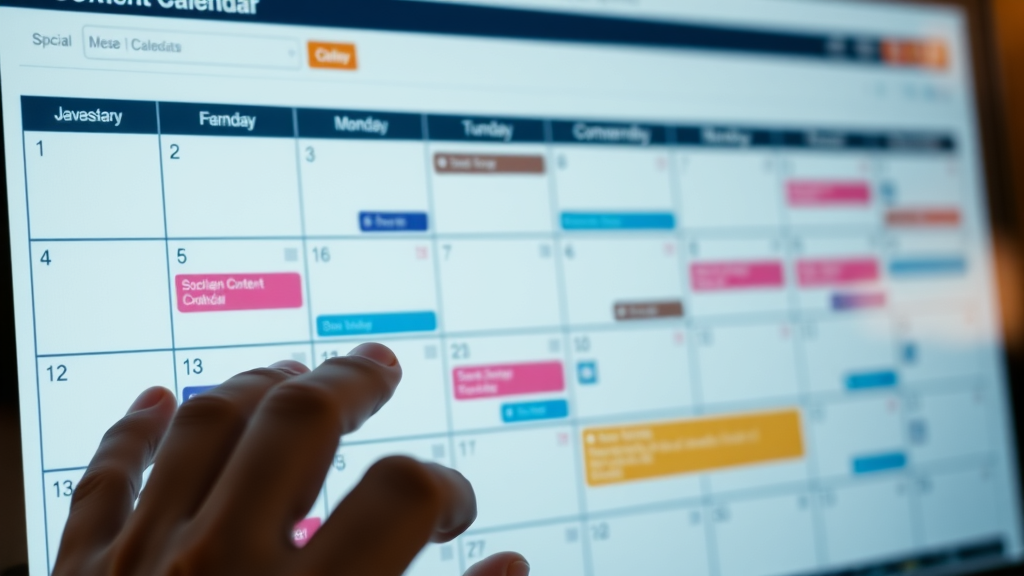Did you know? Marketers who proactively document their content calendar for social media are 538% more likely to achieve dramatic results.* If you crave streamlined workflows and social media wins, a robust content calendar for social media is your ultimate tool. Whether you're part of a seasoned media team or flying solo, this detailed playbook offers 51 actionable steps for building, managing, and maximizing a calendar template that delivers real engagement—and measurable growth.
- Why every media plan needs a rock-solid calendar template
- Step-by-step guide to building a social media content calendar
- The best templates & tools for content planning
- Optimizing posting times for peak engagement
- Avoiding the top 10 social media calendar mistakes
Why a Content Calendar for Social Media Is Non-Negotiable for Success
In today’s attention economy, a content calendar for social media isn’t just helpful—it’s essential. Without an organized approach, posts can become inconsistent, campaigns disjointed, and opportunities lost. A calendar template serves as your strategic control panel, ensuring every media post aligns with your overall social media plan, targets audience touchpoints, and leverages seasonal trends to maximize reach.
By using a dedicated social media calendar template, you empower your content cal and media team with the transparency to plan ahead, collaborate smoothly, and measure progress. It becomes simple to visualize post schedules, manage media content types, and ensure all social channels are delivering value. Moreover, an integrated content calendar template keeps everyone—from copywriters to designers—on the same page, accelerating both content creation and campaign approvals.
Documenting your social media content plan also means your strategy is always on record, readily available for analytics review and fast pivots. As the Content Marketing Institute highlights:
"Companies that document their social media strategy are 538% more likely to report success." – Content Marketing Institute

How to Make a Content Calendar for Social Media: Step-by-Step
Building a smart content calendar for social media blends art and science. The following step-by-step approach covers every aspect from big-picture goals to the granular details of content themes, media type selection, scheduling, and analytics. This is your blueprint for a high-performing, adaptive social media content calendar.
Define Your Social Media Goals Before Building a Content Calendar
Every successful social media content calendar starts with a crystal-clear understanding of your marketing goals and overall social media strategy. Set objectives that are Specific, Measurable, Achievable, Relevant, and Time-bound (SMART)—whether it's increasing brand awareness, driving website traffic, or nurturing a loyal following. Establishing these goals guides every task, from choosing the right media content to deciding how frequently to post. Work backward from your goals to inform the structure of your calendar template and steer your content plan in the right direction.
For instance, if your top priority is audience engagement, your calendar should prioritize content types and formats that spark interaction—like polls, live videos, or user-generated media posts. For a media content calendar with a heavy product launch pipeline, map out content themes and campaign timelines well in advance so that every post ladders up to a larger media strategy. Having clear goals keeps your media team focused, efficient, and agile.
Audit Existing Social Media Content and Channels
Before designing anything new, review all your current social media content and evaluate the effectiveness of each social channel. This crucial audit reveals what's working (and what’s not), what gaps exist, and where your audience is most engaged. Export analytics from platforms like Facebook Insights, Twitter Analytics, or built-in reporting tools to measure the reach, engagement, and success of previous campaigns. Identify your best-performing media posts and recurring content types, and use those insights as a foundation for your new social media content calendar.
Make sure to assess each social network individually—what resonates on LinkedIn may flop on Instagram. Evaluate the frequency of your posts, engagement metrics, and timing for each social media post. Record all findings in a google sheet or dedicated calendar template so you have a data-backed baseline to inform your next steps.

Choose Content Calendar Templates that Fit Your Workflow
The right calendar template is the backbone of your content cal. Whether you use a simple spreadsheet or a robust management tool, make sure your template covers the essentials: dates, post types, captions, media assets, approval statuses, channels, and results tracking. There are many downloadable social media calendar templates available—choose one tailored to your media team’s needs, content plan, and approval workflows.
Some prefer a fully digital calendar template built in Google Sheets or project management platforms like Asana or Trello, as these allow for real-time collaboration, color-coded categories, and easy updates across teams. Others thrive with beautifully designed, printable calendar templates for at-a-glance reference and manual planning by the social media team. Whatever you select, ensure it’s easy to adapt and share.
Select Tools for Your Content Calendar: Google Sheets vs. Calendar Templates
Google Sheets remains a popular, highly flexible choice for building a dynamic content calendar for social media. Its intuitive layout supports color-coding, file attachments, real-time collaboration, and custom filters. For teams managing high volumes of media content, using Google Sheets streamlines edits and version history, reducing email chains and confusion.
On the other hand, purpose-built social media calendar templates often feature drag-and-drop formatting, visual scheduling, and direct integrations with social platforms or third-party schedule posts tools. These let you preview and assign media posts, automate reminders, and schedule posts across multiple channels in seconds. Some top platforms include Hootsuite, Buffer, and CoSchedule—each with their own approach to the content calendar template. Consider your media team’s scale, workflow complexity, and forecasting needs when making your selection.

Map Out Key Social Media Campaigns in Your Content Calendar
An impactful media content calendar schedules major campaigns far in advance, bringing order to launches, holidays, and evergreen posts. Start with confirmed company initiatives: product launches, seasonal moments, partnership announcements, and brand storytelling opportunities. Pre-loading these dates into your calendar template gives your media team time for concept development and creative approvals.
Use your calendar template to anchor larger initiatives—just as you would with an editorial calendar—so smaller, recurring posts can orbit around the big moments. Creating a social media content calendar with campaign pillars helps you monitor key milestones, delegate responsibilities, and ensure no opportunity is overlooked across your social channels. Don’t forget to include important deadlines for asset delivery, copywriting, and publishing in your content plan.
Establish Content Types: Media Content, Blog Posts, Video, and More
Every robust content calendar for social media is anchored by diverse content types. Map out your mix: photos, graphics, blog highlights, videos, short-form stories, infographics, live events—tailoring each piece according to the strengths of your social network. Structuring your media content calendar this way guarantees a steady stream of engaging material that appeals to your different audiences and supports your brand’s marketing goals.
When designing your calendar template, list every content type and pair it with the channels best suited for each format. For example, feature videos and reels on Instagram and YouTube, while deeper blog posts may work best on LinkedIn. Use color-coded categories in the calendar so the social media team can see at a glance what’s scheduled each day, ensuring balanced media content distribution across your editorial calendar.
Top 10 Calendar Templates for Social Media and Media Content
Selecting the right calendar template is key to efficient workflow and measurable results. Here are the most popular options for managing your media content calendar template or social media calendar template needs—each offering unique strengths for different teams and strategies.
| Template Name | Best For | Features | Pricing | Pros | Cons |
|---|---|---|---|---|---|
| Google Sheets Calendar Template | Teams of All Sizes | Real-time Collaboration, Customizable, Free | Free | Highly flexible, easy sharing | Manual updates, lacks automation |
| Asana Social Media Calendar | Agile Teams | Workflow Integration, Task Assignments | Freemium | Visual workflow, great collaboration | Learning curve for new users |
| Hootsuite Planner | High Volume Posting | Calendar View, Automated Scheduling | Paid | Social integrations, analytics | Costly for small teams |
| CoSchedule Calendar Template | Large Organizations | Editorial planning, asset management | Paid | All-in-one suite | Premium price |
| Trello Content Calendar Board | Visual Learners | Card-based, Drag-n-Drop | Free | Highly visual, easy for teams | Limited analytics |
| Buffer Publishing Calendar | Simplified Scheduling | Queue Management, Analytics | Freemium | Clean interface | Limited free version |
| Airtable Social Media Base | Custom Solutions | Database Functions, Templates | Freemium | Customizable, powerful filters | Complex for beginners |
| Notion Media Content Calendar | Makers & Creatives | Modular, Collaborative, Integrations | Free/Paid | Infinite customization | Needs setup time |
| Sprout Social | Enterprise Teams | Integrated Analytics, Campaign Tagging | Paid | Insightful reporting | Pricey |
| Monday.com Content Calendar | Scaling Teams | Automation, Timeline Views | Freemium | Automations, real-time collaboration | Paid features locked |
Designing a Social Media Content Calendar Template That Works
An exceptional social media calendar template combines clear organization, high adaptability, and real-world usability. Your template should provide at-a-glance clarity for upcoming posts, status updates, assigned media team members, due dates, asset attachments, and performance metrics for each social channel.
What Makes a Great Social Media Calendar Template?
Look for templates that make it easy to color code, label by content type, and set filters for campaigns or platforms. Integrate approval checkboxes so your media content and social media posts never go live before review. Your template should allow for attaching creative assets, linking to copy drafts, and scheduling reminders for deadlines—making progression through your content creation and content plan seamless and error-free.
Regularly update your calendar template with feedback from analytics (such as top-performing media posts or campaigns) to ensure your content strategy is continually optimized. Remember, the best social media content calendar is one your entire team will actually use!

How Editorial Calendars Drive Consistency in Content Calendars
An editorial calendar acts as the backbone for a consistent content calendar for social media . By aligning your media content calendar with editorial planning, you ensure that every social media post supports larger brand narratives and strategic priorities. Editorial calendars also help balance high-frequency social media content with long-form or episodic stories, avoiding content fatigue and keeping your audience engaged throughout.
Consistency is what distinguishes great brands—they show up regularly, deliver value every week, and foster trust with their following. Your editorial calendar also streamlines collaboration between the social media team, creative department, and marketing stakeholders, so your media strategy and campaigns run like clockwork.
Incorporating a Media Calendar Template for All Channels
A robust media calendar template centralizes planning for every platform you publish on—from Facebook and Instagram to LinkedIn, YouTube, Twitter, and emerging channels. Each social network has its quirks, preferred posting frequencies, and ideal formats. Adding per-channel tabs or columns to your calendar template provides clearer scheduling, limits overlap, and ensures every platform’s audience receives tailored, high-quality content.
Integrating your media content calendar template with tools for automated schedule posts, analytics tracking, and asset management makes updating and reporting on your social media plan a breeze. This keeps your media team agile and ready for rapid changes in social trends or campaign priorities.
Content Ideas: Filling Your Media Content Calendar With Engagement
Need inspiration to fill your media content calendar or social media content calendar ? Here are five proven post types guaranteed to energize your audience and create ongoing engagement across your social channels:
- User-generated content
- Behind-the-scenes moments
- Product launches
- Seasonal campaigns
- Live media content

Scheduling Media Content: Choosing the Best Posting Times
The best content cal is only as effective as its execution. Schedule your media content for high-traffic windows when your target audience is most active. Each social network has preferred times for maximum reach and interaction—research platform analytics or industry benchmarks to pin point optimal slots for your brand. Factor time zones, holidays, and major events into your scheduling to avoid missed opportunities.
How to Optimize Your Social Media Content Calendar for Peak Engagement
To boost visibility and performance, stagger your posts across different days and times. Use your social media calendar to space out content so you aren’t overwhelming your followers all at once—and use A/B testing tools to experiment with timeslots for the best engagement. Analytics dashboards in most management tools (like Buffer or Hootsuite) allow you to track what’s working and shift your media posts accordingly.
Don’t forget to keep evergreen content in the mix. These posts retain relevance over time and fill gaps during slow news cycles, keeping your media content calendar consistent without reinventing the wheel every week.

Leveraging Analytics for Social Media Planning
The secret to long-term social media growth is continuous feedback. Use analytics from your calendar template or built-in channel dashboards to identify what content, timing, and formats work best. Compare engagement, click-through rates, and conversions for every media post across your channels. Regular analytic reviews inform better media strategy adjustments, helping ensure your content calendar remains data-driven rather than guesswork.
Share these insights with your media team, using the findings to adapt your social media plan and content creation pipeline. Analytics should drive not only optimizations but also creative experimentation throughout your editorial calendar and content plan.
What Should a Social Media Content Plan Include?
A winning social media content calendar is much more than a list of dates and captions. Include the following essentials to ensure clarity and operational efficiency:
- Content themes for each week or month
- Post frequency guidelines
- Content approval workflows
- Media assets tracker
- Call-to-action for each post
- Results tracking
This structure keeps your content cal organized, supports consistent branding, and enables your media team to perform efficiently even as your campaign complexity grows.
What Is Social Media Content Scheduling?
Social media content scheduling means planning and queuing your posts to go live automatically at specific dates and times. This ensures regular posting, reduces manual errors, and allows your content cal to run on autopilot while you focus on engagement and campaigns. With a strong media content calendar and automation tools, you can maintain a steady social presence across channels—even during weekends, holidays, or busy periods.
The Benefits of Automating Your Social Media Content Calendar
By automating your content calendar for social media , your team reclaims hours of manual effort, reduces publishing delays, and avoids last-minute scrambles. Automation tools like Buffer, Hootsuite, or Sprout Social allow you to pre-schedule content cal assets in bulk, guaranteeing your social media posts reach your audience at the perfect time—all while tracking real-time analytics. Auto-scheduling also keeps your social media team focused on strategy and creativity rather than daily logistics.

Recommended Tools for Social Media Content Scheduling
Choosing the right management tool for your social media content calendar boosts efficiency and reliability. Top solutions include Buffer (for intuitive publishing and analytics), Hootsuite (for bulk scheduling and multi-account management), Sprout Social (for advanced analytics), and Later (for visual-first planning). Many let you assign roles, track content performance, store media assets, and collaborate in real time via a unified interface.
Google Sheets also remains a favorite for teams wanting a minimal budget or maximum customization. Regardless of platform, make sure your scheduling tool integrates seamlessly with your chosen calendar template and content plan.
Video: Real-World Content Calendar for Social Media Walkthrough
See a real content calendar for social media in action! Watch this walkthrough on building out your first media content calendar template, best practices for teamwork, and live automation tips for 2024.
Media Content Calendar Template vs. Social Media Calendar Template
While some use these terms interchangeably, a media content calendar template often refers to scheduling all types of media (video, blog, newsletter, podcast, etc.), while a social media calendar template focuses solely on posts distributed directly via social channels. Understanding the distinction helps you plan resources, creative, and timing across your entire media plan—not just social posts.
| Feature | Media Content Calendar Template | Social Media Content Calendar Template |
|---|---|---|
| Scope | All media channels (blog, video, podcast, PR) | Social media platforms only |
| Audience | Internal creative/marketing teams | Social media team/managers |
| Typical Content Types | Articles, media releases, webinars, podcasts | Post captions, images, stories, live streams |
| Approval Flows | Integrated with broader content plan | Quick approvals for fast turnaround |
| Tools | Editorial calendar, project management tool | Scheduling/publishing platforms |
Maximizing ROI with a Strategic Content Calendar for Social Media
The right content calendar for social media is your ROI engine—timely campaigns, cohesive brand stories, and consistent posting all add up to stronger results and reduced resource waste. Use analytics to identify high-performing social media posts, respond rapidly to trends, and double down on what drives your core metrics.
Aligning Content Cal with Your Social Media Plan and Business Goals
Revisit your social media plan at least quarterly, ensuring your content cal is aligned with business objectives: audience growth, lead generation, or brand storytelling. Bring in stakeholders from every team—product, sales, media strategy, customer support—to make sure your social media content calendar reflects shifts in business focus or priorities. Regular updates transform your calendar template from a static tool into a true business growth driver.

How a Media Strategy Supports Your Content Calendar for Social Media
Your wider media strategy ensures your content calendar supports both day-to-day engagement and long-term brand building. It provides the guiding themes, tone, and KPIs that keep your posts on message, on target, and on track. When your media content calendar and social media strategy work together, your campaigns gain narrative depth, consistency, and measurable growth.
"A successful content calendar for social media transforms guesswork into an organized, measurable strategy."
Top 10 Social Media Calendar Mistakes to Avoid
- Ignoring audience insights
- Publishing inconsistently
- Lack of post diversity
- Forgetting to update
- Missing seasonal trends
- Overscheduling sales content
- Neglecting performance analytics
- Having unclear responsibilities
- Failing to repurpose top media content
- Skipping collaboration

FAQs on Building the Ultimate Content Calendar for Social Media
How to make a content calendar for social media?
Start by clarifying your marketing goals and auditing your existing media content and channels. Choose or create a flexible calendar template—Google Sheets are a great start, but dedicated scheduling platforms maximize efficiency. Map out campaigns, set approval flows, and regularly review analytics. Most importantly, keep your content cal updated and adaptable to new trends.
What is a typical content calendar?
A typical content calendar is an organized schedule outlining every planned social media post across your chosen platforms. It usually includes post dates, content types, captions, media assets, responsible team members, channels, and results tracking. Think of it as your control tower for social media activity—ensuring consistency and clear communication among the media team.
What should a social media content plan include?
Your plan should cover audience personas, core messaging, post frequency, preferred media types for each social channel, content approval workflows, an asset library, and measurable KPIs for results. With these pillars set in your media content calendar, you can drive meaningful engagement while ensuring every social media post aligns with your business goals.
What is social media content scheduling?
Social media content scheduling is the process of programming your posts to publish automatically according to your content cal. Using a calendar template and automation tool, you can line up posts weeks (or months) in advance, so your brand remains reliably active, even outside work hours. Scheduling also improves consistency and reduces workload for your social media team.
Video: How a Content Calendar for Social Media Powers Brand Growth
Watch brand leaders share real case studies on leveraging a content calendar for social media to accelerate growth, streamline team collaboration, and supercharge campaign launches.
Best Practices: Maintaining Your Content Calendar for Social Media
- Hold monthly review meetings
- Update your media content calendar templates regularly
- Incorporate feedback from social media analytics
- Schedule evergreen and timely content
- Collaborate in real time on shared calendar templates
Insights From Experts on Social Media Content Calendar Management
"Consistent planning empowers creativity—and a well-used content calendar for social media is the secret weapon of leading brands."
People Also Ask: How to Make a Content Calendar for Social Media?
Start by defining your strategy, choosing relevant content pillars, and selecting an adaptable calendar template. Document which team member is responsible for each stage—from ideation to approval to scheduling. Regularly audit results and re-align your posts with business priorities for continuous growth on every social channel.
People Also Ask: What Is a Typical Content Calendar?
A typical content calendar lays out what, when, and where you’ll post content across all channels. It includes specifics like dates, times, post formats, platform notes, and campaign assignments. Most brands prefer digital templates for ease of sharing and quick updates.
People Also Ask: What Should a Social Media Content Plan Include?
Your content plan should list campaign goals, theme forecasts (monthly or quarterly), content themes, approval pathways, CTAs per post, and metrics for KPIs. This keeps teams aligned and operations streamlined.
People Also Ask: What Is Social Media Content Scheduling?
Content scheduling uses management tools to queue up posts and automate publication across platforms. This approach ensures your message reaches your audience even when you’re off the clock, making your media content calendar indispensable for consistent, always-on social media strategy.
Video: Monthly Content Calendar for Social Media Content Review – Best Practices
Explore monthly review rhythms that help leading brands refine their content cal and media content strategy to maximize results every quarter.
Key Takeaways from Building a Content Calendar for Social Media
- Strategic content calendars drive consistency and success
- Templates and scheduling tools save time and improve teamwork
- Regular updates and analytic reviews are critical to social media growth
Planning Your Next Steps: Download Your Free Content Calendar for Social Media Template
Ready to elevate your results? Download a free content calendar for social media template and kickstart your next winning campaign today! Keep iterating and reviewing your calendar template as your strategy evolves.
Take action: Organize your content, empower your media team, and watch your brand thrive—one scheduled post at a time.
To enhance your understanding of building an effective content calendar for social media, consider exploring the following resources:
-
“Free Social Media Calendar Template for 2025” : This resource provides a customizable template to help you organize and schedule your social media content efficiently. ( sproutsocial.com )
-
“How to Create a Social Media Content Calendar For Your Brand (FREE TEMPLATE)” : This guide offers a step-by-step approach to creating a social media content calendar, complete with a free template to get you started. ( oberlo.com )
These resources offer practical tools and insights to streamline your content planning process and enhance your social media strategy.
 Add Row
Add Row  Add
Add 




Write A Comment